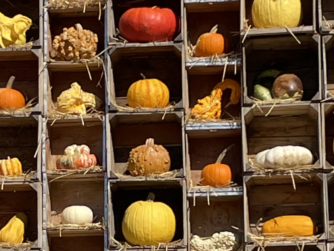Hello darkness, my old friend
I’ve come to talk with you again
Because a vision softly creeping
Left its seeds while I was sleeping
And the vision that was planted in my brain
Still remains
Within the sound of silence
Ugh, the good old “Fall Back” in fall. As autumn brings in the colder temperatures and leaves changing colors, it also brings with it the end of Daylight Saving Time. For some the one-hour time shift provides a little extra sleep, but it also marks the beginning of darker and colder months. This transition can impact our mental and emotional well-being, and for some, it can even lead to Seasonal Affective Disorder (SAD).
I remember back in the early aughts when I lived in LA, where it was usually sunny and warm year round. There was a period of a week straight of gray skies and rain. I was driving to the gym, stopped at a red light, and this deep sadness hit me. I had no idea what was happening. I was always a glass half-full kind of girl and had nothing to be sad about. A few years later, I first heard of the term SAD, or Seasonal Affective Disorder. It all clicked.
Every year, on the first Sunday of November, many of us set our clocks back by one hour, “gaining” an extra hour of sleep. While this sounds like a small, even beneficial change, it can have a huge effect on our routines, mood, and overall mindset.
People have now coined the word Daylight Saving Scare or Daylight Saving Scaries.
Why Does Daylight Saving Time Cause Anxiety?
At first glance, gaining an extra hour of sleep sounds like a gift. But for many, the disruption to our internal body clocks can lead to a sense of imbalance. The earlier onset of darkness can make the days feel shorter, which can affect our mood, energy levels, and productivity.
For those sensitive to changes in light and sleep patterns, the transition can stir up feelings of disconnection, confusion, and even sadness. This is often exacerbated by the natural decline in daylight as winter approaches, leading to what some call “winter blues” or, in more severe cases, Seasonal Affective Disorder (SAD).
As we fall back, our minds and bodies have to readjust to new rhythms, and while the shift might seem minor, it can feel like a bigger challenge mentally. For those juggling busy schedules, family, or work, this small adjustment can feel
Many people begin to experience what’s known as the Daylight Saving scare or scaries. It’s that anxious feeling of unease as we prepare to set our clocks back an hour and face the darker, shorter days of winter. This unsettling feeling is more common than we realize and has significant implications for our mental health, energy levels, and overall sense of balance as we transition into the colder months.
Daylight Saving Time (DST) brings with it changes that go beyond resetting our clocks. The earlier sunsets and sudden shift in our daily routines can lead to sleep disruptions, mood changes, and even difficulties staying focused or motivated. The “fall back” often throws our natural body rhythms out of sync, and it can take days, or even weeks, to adjust.
For many, the earlier darkness can create a feeling of lost time, as though the day is cut short before we’re ready to wind down. Coupled with the shorter days of winter, this can amplify the sense of isolation, lack of productivity, or even a mild depression, as the amount of natural light we receive diminishes drastically. This feeling of losing daylight can make everything from commuting to simply maintaining energy throughout the day feel harder than usual.
Our own neighbors from the west coast ending up moving back to the west coast last year after experiencing the dread of the dark gloomy days and nights here in Cleveland during the winter. It is a real thing so first and foremost always talk to your doctor when the sadness feels like too much.
Here’s why falling back often feels so blah:
- Decreased Sunlight Exposure: With the clocks shifting, we lose an hour of evening daylight. Shorter days and less exposure to natural light can lead to a noticeable drop in mood and energy levels.
- Disrupted Sleep Patterns: While the time change may grant an extra hour of sleep, it can also disrupt our internal body clocks, causing sleep disturbances, especially for those with sensitive sleep patterns.
- Adjusting Daily Routines: The clock shift forces us to realign our daily schedules. This can impact productivity, focus, and our sense of time as we try to make the adjustment.
The Connection to Seasonal Affective Disorder (SAD)
For some, the transition to darker months can trigger a more serious condition: Seasonal Affective Disorder. SAD is a type of depression that typically occurs in the fall and winter, when sunlight is limited. Common symptoms include:
- Persistent feelings of sadness or hopelessness
- Increased fatigue and sleep disturbance
- Changes in appetite (especially carb cravings)
- Difficulty concentrating
- Social withdrawal
Even if you don’t experience full-blown SAD, the shift in light and temperature can leave you feeling more sluggish, irritable, or low in energy.
Coping with the Time Change and Darker Days
The good news is that there are practical steps you can take to lessen the impact of Daylight Saving Time on your mental and emotional health. Here’s how to navigate the fall back with a more positive mindset:
- Light Therapy: Consider investing in a light therapy box that mimics natural sunlight, which can help regulate your body’s internal clock and alleviate SAD symptoms.
- Maintain a Routine: Stick to a consistent sleep and wake schedule, even with the time change. Routine is essential for helping your body adjust and keeping your mood stable.
- Get Outside for Morning Light: Exposing yourself to daylight in the morning can help reset your circadian rhythm, improving your mood and energy throughout the day. Take a morning walk or simply sit by a sunny window.
- Stay Active: Physical movement is one of the best ways to boost your mood. Whether it’s a morning walk, yoga, or hitting the gym, exercise helps combat that sluggish, low-energy feeling.
- Engage in Cozy Activities: Lean into the slower pace of autumn and winter. Spend time reading, baking, or enjoying quiet evenings at home. These activities can bring comfort and help counteract the gloominess of shorter days.
- Seek Support if Needed: If the seasonal shift is hitting you hard, it’s okay to seek help. A therapist can offer guidance and strategies to manage SAD or seasonal mood changes.
- Mindful Eating: As the days grow darker, it’s easy to reach for comfort food. Try to maintain a balanced diet rich in nutrients, which can help support your mood and overall health.
As we set our clocks back and adjust to shorter days, it’s important to recognize how this shift can influence our mental health. The “fall back” can feel like a sudden drop into darkness, but by being proactive and intentional, we can manage the transition with greater ease. While it’s tempting to feel overwhelmed by the lack of light and warmth, this season also offers an opportunity for reflection, rest, and restoration.
I hope that by embracing the slower, cozier pace of the season, you can find balance in both your mental and emotional health. So, hello darkness, my old friend it’s time to work with you, not against you.
Remember if feelings of sadness become too overwhelming to reach out to a professional and talk to someone.







